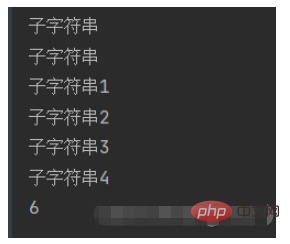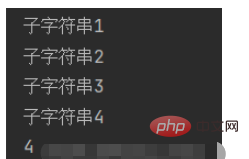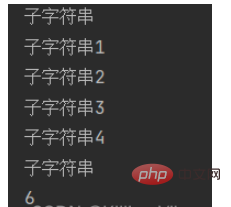How to use String.split() in Java
Apr 18, 2023 pm 01:19 PM1. split(regex,limit)
The first is the split method with two parameters:

Function:
Will separate the strings of the given regular expression (regex)
The first parameter is the separated character type passed in Symbol , such as "," etc. (can be any string)
The second parameter is passed in the integer limit, which represents this string Split into n parts (n here is limit).
Return value:
The array returned by this method Contains each substring of this string. These substrings end with the matched regular expression (that is, the first parameter regex entered), or by the string's Ending as an end.
Note:
The substrings in the array are arranged in the order in which they appear in this string.
If the input regex does not match any characters in the string, then the result array will have only one element, which is this string. (That is, if the input regex parameter does not appear in the string)
If there is a positive match at the beginning of the string (that is, there are >0 regex separations at the beginning of the string) symbol), then an empty leading substring will be included at the beginning of the result array.
public class test {
public static void main(String[] args) {
String str = ",,1,2,3,4"; // 注意這里字符串開頭就匹配到了逗號
String[] s = str.split(",",10);// 這里先取10,后文介紹第二個(gè)參數(shù)
for (String string : s) {
System.out.println("子字符串"+string);
}
System.out.println(s.length);
}
}Running result:
There will be a before the first comma Empty substring

The limit parameter controls the number of times the pattern is applied and therefore affects the length of the resulting array . (The meaning here is that the value of limit controls the length of the result array)

The above interpretation is as follows: (1) If the limit input is a positive number , then this pattern will apply limit - 1 times at most (that is, the input regex will only be used to match limit - 1 times in the string), the length of the array will not be greater than limit, and the last entry of the array will contain All inputs except the last matching delimiter (that is to say, the separated pattern is from the front to the back). Give a code for everyone to understand:
public class test {
public static void main(String[] args) {
String str = "1,2,3,4";
String[] s = str.split(",",2);//這里輸入limit為2,即分成2部分
for (String string : s) {
System.out.println("子字符串"+string);
}
System.out.println(s.length);
}
}Running result:
characters The string is separated into 2 substrings, and the separation pattern is

from front to back (2) If the input limit is zero, the pattern will Applied as many times as possible, the resulting array can have any length, and the empty string at the end will be discarded . (That is, all regex delimiters in the string are matched), and the empty string is discarded , the code is as follows:
public class test {
public static void main(String[] args) {
String str = "1,2,3,4,,,";// 這里后面逗號之間的空字符串將被丟棄
String[] s = str.split(",",0);
for (String string : s) {
System.out.println("子字符串"+string);
}
System.out.println(s.length);
}
}Running results:
The empty string at the end will not appear in the result array

(3 ) If the value of input limit is negative , the pattern will be applied as many times as possible, and the array can be of any length. (The empty string at the end will not be lost)
public class test {
public static void main(String[] args) {
String str = ",1,2,3,4,";
String[] s = str.split(",",-1);//limit值為負(fù)數(shù)
for (String string : s) {
System.out.println("子字符串"+string);
}
System.out.println(s.length);
}
}Running result:
The empty string at the end of the string will not be lost

2. split(regex)
The next split method with only one parameter is easy, that isThe default limit value is 0.

The working principle of this method is to call the two-parameter split method with the given regex parameter and a limit parameter that defaults to 0. Therefore, the trailing empty string is not included in the resulting array.

The above is the detailed content of How to use String.split() in Java. For more information, please follow other related articles on the PHP Chinese website!

Hot AI Tools

Undress AI Tool
Undress images for free

Undresser.AI Undress
AI-powered app for creating realistic nude photos

AI Clothes Remover
Online AI tool for removing clothes from photos.

Clothoff.io
AI clothes remover

Video Face Swap
Swap faces in any video effortlessly with our completely free AI face swap tool!

Hot Article

Hot Tools

Notepad++7.3.1
Easy-to-use and free code editor

SublimeText3 Chinese version
Chinese version, very easy to use

Zend Studio 13.0.1
Powerful PHP integrated development environment

Dreamweaver CS6
Visual web development tools

SublimeText3 Mac version
God-level code editing software (SublimeText3)

Hot Topics
 How to iterate over a Map in Java?
Jul 13, 2025 am 02:54 AM
How to iterate over a Map in Java?
Jul 13, 2025 am 02:54 AM
There are three common methods to traverse Map in Java: 1. Use entrySet to obtain keys and values at the same time, which is suitable for most scenarios; 2. Use keySet or values to traverse keys or values respectively; 3. Use Java8's forEach to simplify the code structure. entrySet returns a Set set containing all key-value pairs, and each loop gets the Map.Entry object, suitable for frequent access to keys and values; if only keys or values are required, you can call keySet() or values() respectively, or you can get the value through map.get(key) when traversing the keys; Java 8 can use forEach((key,value)->
 Java Optional example
Jul 12, 2025 am 02:55 AM
Java Optional example
Jul 12, 2025 am 02:55 AM
Optional can clearly express intentions and reduce code noise for null judgments. 1. Optional.ofNullable is a common way to deal with null objects. For example, when taking values ??from maps, orElse can be used to provide default values, so that the logic is clearer and concise; 2. Use chain calls maps to achieve nested values ??to safely avoid NPE, and automatically terminate if any link is null and return the default value; 3. Filter can be used for conditional filtering, and subsequent operations will continue to be performed only if the conditions are met, otherwise it will jump directly to orElse, which is suitable for lightweight business judgment; 4. It is not recommended to overuse Optional, such as basic types or simple logic, which will increase complexity, and some scenarios will directly return to nu.
 How to fix java.io.NotSerializableException?
Jul 12, 2025 am 03:07 AM
How to fix java.io.NotSerializableException?
Jul 12, 2025 am 03:07 AM
The core workaround for encountering java.io.NotSerializableException is to ensure that all classes that need to be serialized implement the Serializable interface and check the serialization support of nested objects. 1. Add implementsSerializable to the main class; 2. Ensure that the corresponding classes of custom fields in the class also implement Serializable; 3. Use transient to mark fields that do not need to be serialized; 4. Check the non-serialized types in collections or nested objects; 5. Check which class does not implement the interface; 6. Consider replacement design for classes that cannot be modified, such as saving key data or using serializable intermediate structures; 7. Consider modifying
 Comparable vs Comparator in Java
Jul 13, 2025 am 02:31 AM
Comparable vs Comparator in Java
Jul 13, 2025 am 02:31 AM
In Java, Comparable is used to define default sorting rules internally, and Comparator is used to define multiple sorting logic externally. 1.Comparable is an interface implemented by the class itself. It defines the natural order by rewriting the compareTo() method. It is suitable for classes with fixed and most commonly used sorting methods, such as String or Integer. 2. Comparator is an externally defined functional interface, implemented through the compare() method, suitable for situations where multiple sorting methods are required for the same class, the class source code cannot be modified, or the sorting logic is often changed. The difference between the two is that Comparable can only define a sorting logic and needs to modify the class itself, while Compar
 How to handle character encoding issues in Java?
Jul 13, 2025 am 02:46 AM
How to handle character encoding issues in Java?
Jul 13, 2025 am 02:46 AM
To deal with character encoding problems in Java, the key is to clearly specify the encoding used at each step. 1. Always specify encoding when reading and writing text, use InputStreamReader and OutputStreamWriter and pass in an explicit character set to avoid relying on system default encoding. 2. Make sure both ends are consistent when processing strings on the network boundary, set the correct Content-Type header and explicitly specify the encoding with the library. 3. Use String.getBytes() and newString(byte[]) with caution, and always manually specify StandardCharsets.UTF_8 to avoid data corruption caused by platform differences. In short, by
 Java method references explained
Jul 12, 2025 am 02:59 AM
Java method references explained
Jul 12, 2025 am 02:59 AM
Method reference is a way to simplify the writing of Lambda expressions in Java, making the code more concise. It is not a new syntax, but a shortcut to Lambda expressions introduced by Java 8, suitable for the context of functional interfaces. The core is to use existing methods directly as implementations of functional interfaces. For example, System.out::println is equivalent to s->System.out.println(s). There are four main forms of method reference: 1. Static method reference (ClassName::staticMethodName); 2. Instance method reference (binding to a specific object, instance::methodName); 3.
 How to parse JSON in Java?
Jul 11, 2025 am 02:18 AM
How to parse JSON in Java?
Jul 11, 2025 am 02:18 AM
There are three common ways to parse JSON in Java: use Jackson, Gson, or org.json. 1. Jackson is suitable for most projects, with good performance and comprehensive functions, and supports conversion and annotation mapping between objects and JSON strings; 2. Gson is more suitable for Android projects or lightweight needs, and is simple to use but slightly inferior in handling complex structures and high-performance scenarios; 3.org.json is suitable for simple tasks or small scripts, and is not recommended for large projects because of its lack of flexibility and type safety. The choice should be decided based on actual needs.
 Outlook shortcut for new email
Jul 11, 2025 am 03:25 AM
Outlook shortcut for new email
Jul 11, 2025 am 03:25 AM
How to quickly create new emails in Outlook is as follows: 1. The desktop version uses the shortcut key Ctrl Shift M to directly pop up a new email window; 2. The web version can create new emails in one-click by creating a bookmark containing JavaScript (such as javascript:document.querySelector("divrole='button'").click()); 3. Use browser plug-ins (such as Vimium, CrxMouseGestures) to trigger the "New Mail" button; 4. Windows users can also select "New Mail" by right-clicking the Outlook icon of the taskbar






